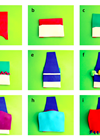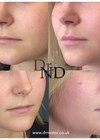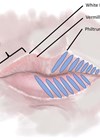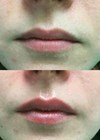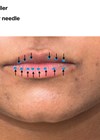From Hollywood lips to Essex lips, non-surgical lip augmentation has gained popularity in recent years with aesthetic patients. A 2019 article in the Journal of Cosmetic Dermatology concluded that the non-surgical correction of the projection of the forehead profile and shape of the nose, lips and chin, provides an overall improvement in facial aesthetics and harmony, and gives a good solution in patients wishing to avoid surgical intervention, scars and general anaesthesia, thus providing the optimum in patient satisfaction [1].
Therefore, you need to meet this demand for non-surgical lip augmentation and treat accordingly to give your patients the best outcome. This article will provide a guide to the anatomy of the lips and a way to assess and treat your patients.
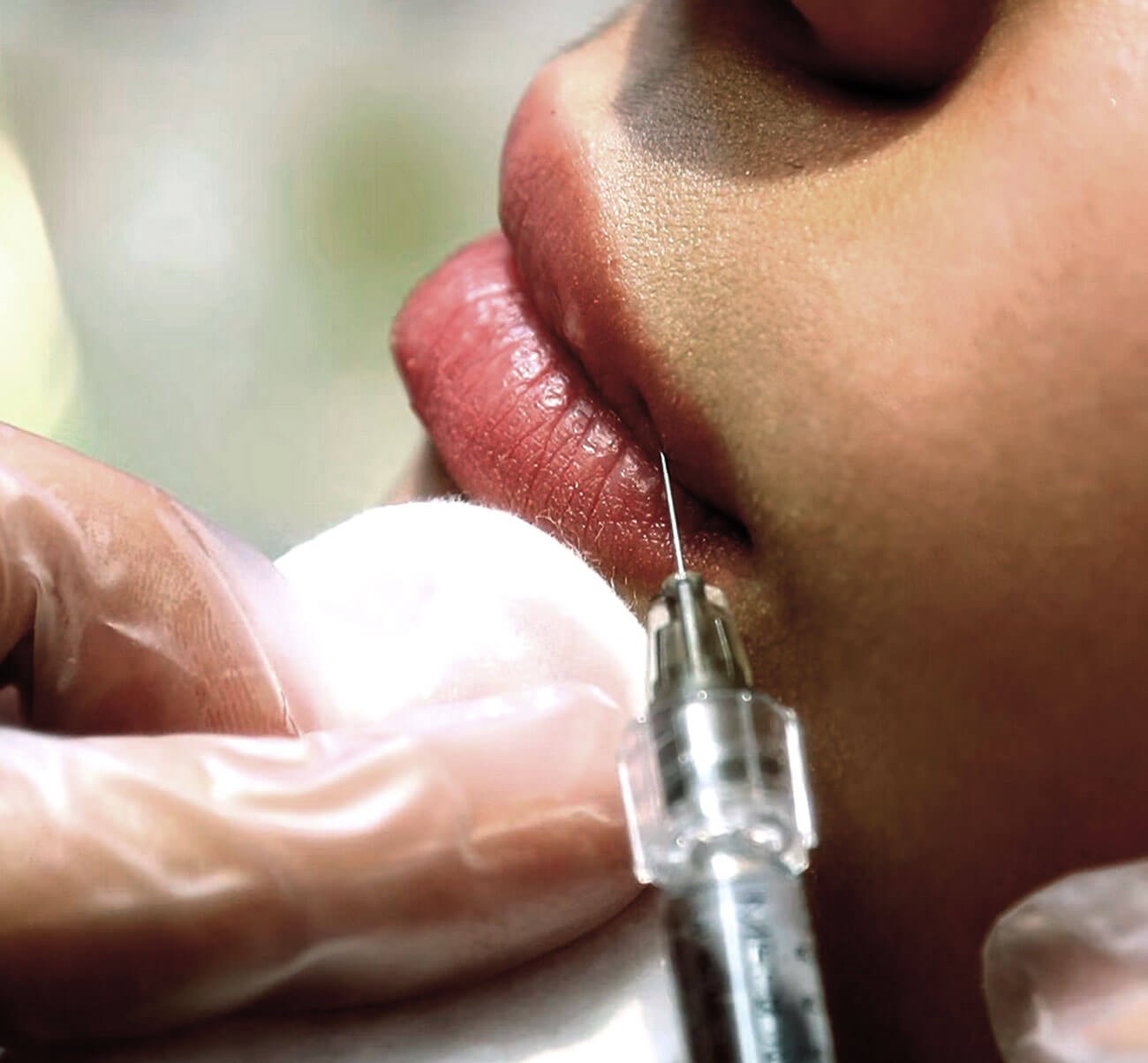
Layers
As with most facial structures, the lips consist of five layers, starting superficially with skin, superficial fat compartments, orbicularis muscle, deep fat compartments and mucosa [2].
Muscles
I have divided the muscles associated with the lips into three parts: Group 1 – muscles that insert into the modiolus; Group 2 – muscles that insert into the upper lip; and Group 3 – muscles that insert into the lower lip.
Group 1 – modiolus
This consists of seven muscles:
- Orbicularis oris
- Levator anguli oris
- Zygomaticus major
- Buccinator
- Risorius
- Depressor anguli oris
- Platysma pars modiolaris
Group 2 – upper lip
The second group of muscles are associated with elevating the upper lip, and consist of the zygomaticus minor, levator labii superioris and levator anguli oris.
Group 3 – lower lip
The third group of muscles are associated with depressing the lower lip. Depressor labii inferioris, mentalis and platysma (pars labialis).
Vessels
The lips receive most of their blood supply from the labial arteries [3]. Due to the various branches, the labial arteries can efficiently provide blood to the lips. Aside from providing blood to the lips for proper function, the blood flow also contributes to the colour in the lips. Adequate blood supply is required to maintain appropriate functioning, including breathing, eating, and facial expression.
The labial arteries are direct branches from the facial arteries. The labial arteries can further subdivide into the superior labial arteries and inferior labial arteries. The superior labial arteries are larger than the inferior labial arteries. The labial arteries branch from the facial artery at the region where the vermillion border of the upper lip meets the vermillion border of the lower lip. The superior labial artery traverses between the mucosal and upper part of the orbicularis oris muscle. The inferior labial artery traverses between the mucosal and lower part of the orbicularis oris muscle. As the labial arteries traverse the lips, they will anastomose with the labial arteries of the contralateral side. The anastomosis forms collateral blood flow for the lips and underlying muscles.
The superior labial arteries form a network around the upper lip. This network contains many branches that contribute to the blood supply for the upper lip, mucosal, and nose. Many small septal branches will provide blood to the lip. Once the superior labial artery reaches the philtrum, it gives off the columellar artery. The columellar artery ascends the philtrum column up to the nasal septum. At the nasal septum, the columellar arteries and septal branches become part of the Kiesselbach plexus at the anterior part of the nasal septum.
"We need to take into account the different requirements from different age groups"
The inferior labial artery traverse the lower lip and fuses with the mental branch of the inferior alveolar artery and the inferior labial artery on the contralateral side. The inferior labial arteries supply the lower lip and the chin region. However, many variations of this pattern have been described.
Ageing
Facial ageing reflects the dynamic, cumulative effects of time on the skin, soft tissues, and deep structural components of the face, and is a complex synergy of skin textural changes and loss of facial volume. Many of the facial manifestations of ageing reflect the combined effects of gravity, progressive bone resorption, decreased tissue elasticity, and redistribution of subcutaneous fullness [4].
As we age, there are marked differences in the appearance of our lips, such as:
- Loss of fullness and projection
- Development of rhytids
- Reduction of the vermillion border
- Inversion of the lower lip
- Reduction of show of the upper teeth
- Increased show of the lower teeth
- Flattening of the Cupid’s bow
- Flattening of the philtrum columns
- Lengthening of the cutaneous upper lip
- Reduction of the nasolabial angle
- Reduction in the mentolabial angle
- Reduction in vermillion pigmentation
Assessment
Young vs. old
We need to take into account the different requirements from different age groups. In our ‘Millennials’, a fuller more projected lip is in vogue as they are often influenced by social media trends, such as the celebrity Kylie Jenner announcing in 2015, at the age of 18, that she had lip fillers. According to the American Society of Plastic Surgeons, there was a 32% increase in dermal filler treatments among 20 to 29-year-olds between 2010 and 2017 (also known as the ‘Millennial Pout’) [5].
Older patients are more likely to want a more natural look and tend to choose their practitioner based on personal recommendations and will take their time to consider all options. They will want to ‘naturally’ enhance what they have and not recreate. They may also prefer to build their lips over a number of treatments spread over several months.
With an older patient you will need to consider the whole face much more than with younger patients, due to loss of collagen, fat, bone and the appearance of more dynamic lines.
Product selection
I use hyaluronic acid-based dermal filler products. Hyaluronic acid (HA), is a natural component of the skin that our bodies make daily. There is no one filler that’s fits all, instead different fillers are emerging as unique products best suited for certain regions given the varying characteristics and aesthetic needs of the face [6].
There are numerous fillers available on the UK market – with several properties that you need to consider. This is a potential minefield, as you need to consider the different viscoelastic, elastic modulus, cohesive, HA concentration, and viscosity properties. To simplify, there are three main product characteristics you need to look at:
Particle size
Particle size – this dictates the amount of volume that is created. Larger particle size will create more volume and hence have a greater longevity. Small particle size will create minimal volume and have the shortest duration [7].
There are instances when you will choose either or both. For more volume in the body of the lips, a medium particle sized product would be preferable. If treating the upper rhytides, then a smaller filler particle would be ideal to prevent an excessive pout.
Cross-linking
Pure HA is very unstable with a very short half-life. The strands of HA when cross linked give longevity to the filler. The higher the degree of cross-linking, the more lifting capacity is given to the filler.
If a patient requires a fuller more pronounced look, then a high cross-linking product would be required. If a more subtle result is required, then a low cross-linking product would be more suitable [6,8].
G prime
This relates to the resistance to force [9]. A high G prime is like a rubber ball: it maintains its shape and is very resistant to force; it will stay where it is put and not be moulded. A low G prime is more like syrup; it will flow and can be moulded to give a smoother, more natural result. A high G prime product would be required for someone with thicker skin, perhaps a younger patient wanting a more chiseled, pronounced result. On the other hand, a low G prime product would be required for someone with thinner skin, the more mature patient looking for a natural, subtle result.
The procedure
Instead of looking at what part of the lip you want to treat, start with the end result in mind. What is the final requirement from the patient and how will you achieve this ideal outcome?
- Definition – vermillion borders
- Projection – body
- Eversion – perpendicular threads
The lips are one of the areas we treat that is highly prone to potential side-effects. Due to the high muscle activity and rich blood supply lips are very sensitive to trauma. Therefore, do not omit to mention or underplay these side-effects to patients. The following immediate side-effects are likely to happen to some extent with all patients so they need to be properly prepared:
- Swelling / oedema
- Bruising
- Tenderness
- Redness
- Lumpiness
- Asymmetry
- Pain
Post treatment remember to discard any unused product as dermal fillers are for single use only.
Summary
To create the optimum result, practitioners need to balance age-specific treatments with the correct product selection. To be safe and get predictable results, follow the 4 Ps:
- Patient – are you happy to see this patient? Do they have realistic expectations? And if they do, can you not only meet them, but exceed them?
- Person – are you the right person to do this treatment? Do you have the confidence and competence to deliver the results the patient wants?
- Product – are you using the right product with the correct properties, such as particle size, degree of cross-linking, and G prime? Don’t forget the lips are movable structures and hence very unforgiving if the wrong product is chosen.
- Plane – do it in the right plane. What depth do you need to be injecting to? Are you aware of the path of the superior and inferior labial arteries? Would a cannula be safer in certain areas of the lips?
Always remember, LESS is more, SIMPLE is best, NATURAL is key.
References
1. Bertossi D, Lanaro L, Dell’Acqua I, et al. Injectable profiloplasty: forehead, nose, lips and chin filler treatment. J Cosmet Dermatol 2019;18(4):976-84.
2. Carey JC, Cohen MM Jr, Curry CJ, et al. Elements of morphology: standard terminology for the lips, mouth, and oral region. Am J Med Genet A 2009;149A(1):77-92.
3. Nguyen JD, Duong H. Anatomy, Head and Neck, Labial Artery. StatPearls [Internet] 2022.
4. Coleman SR, Grover R. The anatomy of the aging face: volume loss and changes in 3-dimensional topography. Aesthetic Surgery Journal 2006;26(1S):S4-9.
5. American Society of Plastic Surgeons. Why are millennials getting Botox and fillers in their twenties? 2017
https://www.plasticsurgery.org/
news/blog/why-are-millennials-getting
-botox-and-fillers-in-their-twenties
6. Attenello NH, Maas CS. Injectable fillers: review of material and properties. Facial Plast Surg 2015;31(1):29-34.
7. Chun C, Lee DY, Kim J-T, et al. Effect of molecular weight of hyaluronic acid (HA) on viscoelasticity and particle texturing feel of HA dermal biphasic fillers. Biomater Res 2016;20(1):24.
8. Falcone SJ, Berg RA. Crosslinked hyaluronic acid dermal fillers: A comparison of rheological properties. J Biomed Mater Res A 2008;87(1):264‑71.
9. Sundaram H. Going with the flow: an overview of soft tissue filler rheology and its potential clinical applications. flow properties and the clinical behavior that these properties predict can be important factors that help clinicians refine and individualize treatment with soft tissue fillers. Practical Dermatology 2010
https://practicaldermatology.com/articles/2010-nov/
cosmetics-challenge-going-with-the-flow-an-overview
-and-clinical-discussion-of-the-rheology-of-soft-tissue
-fillers-part-1-of-2?c4src=ajax-search:feed
[All links last accessed December 2022].
Declaration of competing interests: None declared.
COMMENTS ARE WELCOME




